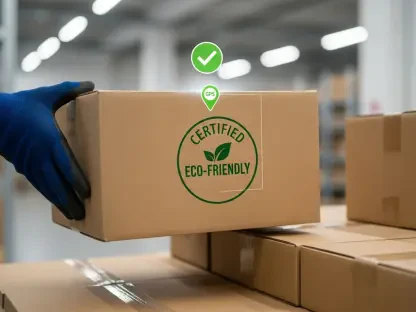Imagine a world where tens of billions of devices operate seamlessly without ever needing to change or recharge a battery, leveraging the very environment around them for power. This vision is rapidly materializing with the advent of Ambient IoT (Internet of Things), a groundbreaking technology that utilizes ambient energy sources such as radio waves, vibrations, temperature differences, and light to power myriad IoT devices. Traditional battery dependency is swiftly becoming a thing of the past as major tech pioneers like Intel, Qualcomm, and Infineon Technologies push the boundaries of this innovation. Even consumer brands, such as PepsiCo, are adopting Ambient IoT to enhance their operational efficiency.
In the next five years, Ambient IoT is anticipated to connect tens of billions of devices, according to insights from IoT Analytics. The substantial increase from 1.18 billion connected IoT devices in 2024 to an estimated 40 billion by 2030 mirrors the profound impact this technology will have across various sectors. Unlike conventional IoT devices, reliant on cables or rechargeable batteries, Ambient IoT devices collect energy from their surroundings, operating in a more sustainable and cost-effective manner. The Ambient IoT Alliance sets the standards guiding this transition, ensuring that devices from different manufacturers can work together effortlessly.
Transforming Smart Manufacturing and Equipment Maintenance
In the revolutionary realm of smart manufacturing and industrial equipment maintenance, energy-harvesting sensors play a critical role. These sensors continuously monitor machine health in real-time, capturing data on temperature, vibration, and operational efficiency. By leveraging this data, businesses can implement predictive maintenance strategies, significantly reducing downtime and extending the lifespan of machinery. This continuous monitoring allows companies to detect potential issues before they cause significant disruptions, thus enhancing production reliability and efficiency.
Furthermore, the implementation of Ambient IoT in manufacturing environments leads to substantial cost savings. Traditional maintenance often involves scheduled checks and routine servicing, which can be both time-consuming and expensive. With real-time data from energy-harvesting sensors, maintenance becomes condition-based, only occurring when needed. This reduces unnecessary maintenance tasks and minimizes costly interruptions in production. Consequently, businesses can allocate resources more effectively, focusing on areas that require immediate attention and optimizing overall operational efficiency.
Enhancing Retail and Inventory Management
Retailers are increasingly turning to Ambient IoT technology to streamline their inventory management processes. Ambient IoT tags, equipped with energy-harvesting capabilities, enable real-time tracking of products throughout the supply chain. This innovative approach provides retailers with accurate and up-to-date stock data, reducing the risk of stockouts and overstock situations. With precise inventory information at their fingertips, retailers can ensure that products are always available on shelves, maximizing sales opportunities and enhancing customer satisfaction.
Moreover, Ambient IoT technology helps retailers tackle one of their biggest challenges: shrinkage. By using energy-harvesting sensors to monitor product movement within stores and warehouses, retailers can effectively reduce theft and loss. These sensors provide real-time alerts when unexpected movements or unauthorized actions occur, enabling swift responses to potential security breaches. The result is improved inventory accuracy and reduced losses, contributing to higher profitability for retail businesses. Additionally, the implementation of Ambient IoT in inventory management systems allows for more efficient restocking processes, ensuring that shelves are replenished promptly and minimizing downtime.
Securing Pharmaceutical Cold Chain Monitoring
The pharmaceutical industry relies heavily on maintaining precise temperature conditions for products like vaccines and other temperature-sensitive goods. Ambient IoT sensors offer a robust solution for ensuring strict compliance with regulatory standards in the cold chain. These sensors, powered by ambient energy sources, provide real-time monitoring of temperature conditions throughout the storage and transportation process. By maintaining an unbroken chain of temperature data, pharmaceutical companies can prevent spoilage and guarantee the efficacy of their products.
The implementation of Ambient IoT technology in pharmaceutical cold chain monitoring also enhances transparency and accountability. With continuous data collection and reporting, companies can provide regulators and stakeholders with detailed insights into the entire supply chain process. This level of visibility ensures that any deviations from the required temperature range are quickly identified and addressed, minimizing the risk of compromised products reaching end consumers. Ultimately, the use of Ambient IoT sensors in the pharmaceutical industry ensures the safe delivery of life-saving medications, reinforcing trust in the supply chain.
Optimizing Supply Chain and Logistics Operations
Supply chain and logistics operations are undergoing a significant transformation with the integration of Ambient IoT technology. Companies are leveraging advanced RFID (Radio-Frequency Identification) and GPS (Global Positioning System) technologies to track shipments in real-time, enhancing logistics efficiency. Ambient IoT devices, powered by ambient energy sources, provide continuous updates on the location and condition of goods throughout the transportation process. This real-time visibility enables companies to make informed decisions, ensuring timely deliveries and reducing losses due to misplacements or delays.
Furthermore, the adoption of Ambient IoT in logistics operations improves asset management. Businesses can monitor the utilization and condition of equipment, such as containers and pallets, optimizing their usage and preventing unnecessary wear and tear. With better asset tracking, companies can streamline their operations, reduce costs, and improve overall efficiency. The integration of Ambient IoT also facilitates automated data collection and reporting, minimizing manual errors and increasing the accuracy of logistics operations. This technological advancement enhances not only the efficiency of supply chains but also the reliability and responsiveness of businesses in meeting customer demands.
Future Considerations and Path Forward
Imagine a world where tens of billions of gadgets run effortlessly without the need to change or recharge a battery, harnessing the environment around them for power. This is the rapidly emerging vision of Ambient IoT (Internet of Things), a revolutionary technology that leverages ambient energy sources like radio waves, vibrations, temperature differences, and light to power an array of IoT devices. The reliance on traditional batteries is quickly fading as tech giants like Intel, Qualcomm, and Infineon Technologies advance this innovation. Even consumer companies like PepsiCo are embracing Ambient IoT for improved efficiency.
Within the next five years, it’s predicted that Ambient IoT will connect tens of billions of devices, as per IoT Analytics’ projections. The dramatic rise from 1.18 billion connected devices in 2024 to an estimated 40 billion by 2030 highlights the transformative impact this technology will have across multiple sectors. Unlike conventional IoT devices dependent on cables or rechargeable batteries, Ambient IoT devices harvest energy from their environment, promoting sustainability and cost-efficiency. The Ambient IoT Alliance sets the standards for this shift, ensuring compatibility among devices from various manufacturers.









